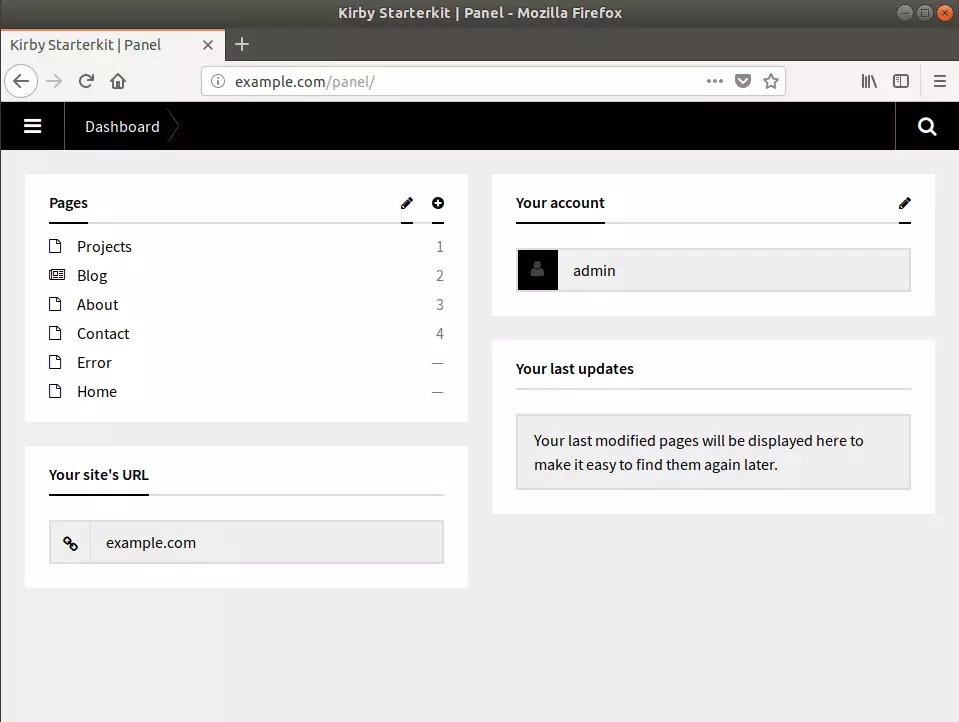This article explains installing Kirby CMS on Ubuntu Linux with Apache support.
Kirby is a flat-file Content Management System (CMS) with no database involved. It helps you create your personal or business websites in minutes by uploading their content to your server.
Installing Kirby CMS with Apache on Ubuntu Linux allows you to create your own personal or business website easily. Kirby is a flat-file CMS that doesn’t require a database server, making it a lightweight and efficient solution for those who want to manage content without needing a database.
Apache is the most popular web server, offering a reliable and secure way to serve your website content. Following the steps outlined in the tutorial, you can easily install Kirby CMS with Apache on your Ubuntu Linux server and start creating your website.
For more about Kirby, please check its homepage.
Install Apache2 HTTP Server on Ubuntu
Apache2 HTTP Server is the most popular web server in use. Install it since Kirby needs it.
To install Apache2 HTTP on the Ubuntu server, run the commands below.
sudo apt update sudo apt install apache2
After installing Apache2, the commands below can stop, start, and enable the Apache2 service to always start up with the server boots.
sudo systemctl stop apache2.service sudo systemctl start apache2.service sudo systemctl enable apache2.service
To test the Apache2 setup, open your browser and browse to the server hostname or IP address. You should see the Apache2 default test page, as shown below. When you see that, then Apache2 is working as expected.
http://localhost

Install PHP 7.2 and Related Modules
PHP 7.2 may not be available in Ubuntu default repositories for some systems. So, you will have to get it from third-party repositories if you need it.
Run the commands below to add the below third party repository to upgrade to PHP 7.2
sudo apt-get install software-properties-common sudo add-apt-repository ppa:ondrej/php
Then update and upgrade to PHP 7.2
sudo apt update
Next, run the commands below to install PHP 7.2 and related modules.
sudo apt install php7.2 libapache2-mod-php7.2 php7.2-common php7.2-mbstring php7.2-xmlrpc php7.2-sqlite3 php7.2-soap php7.2-gd php7.2-xml php7.2-cli php7.2-curl php7.2-zip
After installing PHP 7.2, run the commands below to open the PHP default config file for Apache2.
sudo nano /etc/php/7.2/apache2/php.ini
Then, save the changes on the following lines below in the file. The value below is an excellent setting to apply in your environment.
file_uploads = On allow_url_fopen = On memory_limit = 256M upload_max_filesize = 100M max_execution_time = 360 date.timezone = America/Chicago
After making the change above, please save the file and close it out.
After installing PHP and related modules, you must restart Apache2 to reload PHP configurations.
To restart Apache2, run the commands below
sudo systemctl restart apache2.service
To test PHP 7.2 settings with Apache2, create a phpinfo.php file in the Apache2 root directory by running the commands below
sudo nano /var/www/html/phpinfo.php
Then, type the content below and save the file.
<?php phpinfo( ); ?>
Save the file. Then browse to your server hostname followed by /phpinfo.php
http://localhost/phpinfo.php
You should see the PHP default test page.

Download Kirby’s Latest Release
Next, visit the Kirby site and download the latest package. Or run the commands below to download Kirby packages from GitHub.
After downloading, run the commands below to extract the downloaded file and move it into a new Kirby root directory. After that, change into the Kirby root directory to install the PHP-required packages.
Take notes of the branch number. If there are newer branch numbers, replace the one below with them.
cd /var/www/html/ sudo apt install git sudo git clone --recursive https://github.com/getkirby/starterkit.git kirby
Then, run the commands below to set the correct permissions for Kirby to function correctly.
sudo chown -R www-data:www-data /var/www/html/kirby/ sudo chmod -R 755 /var/www/html/kirby/
Configure Apache2 Kirby Site
Finally, configure the Apache2 configuration file for Kirby. This file will control how users access Kirby’s content. Run the commands below to create a new configuration file called Kirby.conf.
sudo nano /etc/apache2/sites-available/kirby.conf
Then copy and paste the content below into the file and save it. Replace the highlighted line with your domain name and directory root location.
<VirtualHost *:80>
ServerAdmin admin@example.com
DocumentRoot /var/www/html/kirby/
ServerName example.com
ServerAlias www.example.com
<Directory /var/www/html/kirby/>
Options FollowSymlinks
AllowOverride All
Require all granted
</Directory>
ErrorLog ${APACHE_LOG_DIR}/error.log
CustomLog ${APACHE_LOG_DIR}/access.log combined
</VirtualHost>
Save the file and exit.
After configuring the VirtualHost above, please enable it by running the commands below.
Enable the Kirby Site and Rewrite Module
After configuring the VirtualHost above, please enable it by running the commands below, then restart the Apache2 server.
sudo a2ensite kirby.conf sudo a2enmod rewrite
Restart Apache2
sudo systemctl restart apache2.service
Next, open your browser and browse the server hostname or IP address. You should see the Kirby page.
http://example.com

Kirby is a databaseless flat file content management system. Its structure allowed you to have just the amount of functionality needed in a flat file CMS solution, adding extensions (blade packs) for additional functionality while allowing setup on simple servers with no database.
To login to the backend panel, go to the address below:
http://example.com/panel/install
You’ll be prompted to create a new admin account.

You should be able to log on with the username and password you created.

After creating the first admin account, you can return to the backend by using the URL below:
http://example.com/panel/login
Enjoy!
You have successfully installed Kirby CMS on Ubuntu 16.04 | 18.04 and 18.10. For more tutorials on Ubuntu, please search our site.

Leave a Reply to CNTInstructor Cancel reply